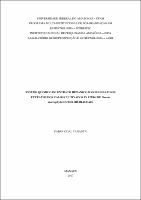| ???jsp.display-item.social.title??? |


|
Please use this identifier to cite or link to this item:
https://tede.ufam.edu.br/handle/tede/6939| ???metadata.dc.type???: | Dissertação |
| Title: | Estudo químico do extrato hexânico das folhas e dos extratos dos calos cultivados in vitro de Duroia macrophylla Huber (Rubiaceae) |
| ???metadata.dc.creator???: | Tananta, Fabio Vidal  |
| ???metadata.dc.contributor.advisor1???: | Nunez, Cecília Verônica |
| ???metadata.dc.contributor.referee1???: | Ramos, Daiane Martins |
| ???metadata.dc.contributor.referee2???: | Nunomura, Sergio Massayoshi |
| ???metadata.dc.description.resumo???: | Muitos fármacos sintéticos têm alguma relação com as substâncias isoladas de plantas que foram foco de estudos fitoquímicos. Neste trabalho, a espécie vegetal escolhida foi a Duroia macrophylla (Rubiaceae), popularmente conhecida como "apurui" ou "puruigrande-da-mata", a qual é rica em substâncias como terpenos e alcaloides, o que pôde ser verificado através das análises e estudos anteriormente realizados. Neste contexto, o objetivo deste trabalho foi realizar o fracionamento do extrato hexânico das folhas de Duroia macrophylla, dos extratos hexânico, acetato de etila e metanólico de seus calos obtidos in vitro, e ainda, avaliar a atividade antimicrobiana dos extratos. O extrato hexânico das folhas de D. macrophylla foi fracionado e em três frações foi identificado o sitosterol como principal constituinte e um sequiterpeno como constituinte majoritário de uma fração, porém a sua estrutura não pôde ser identificada. O fracionamento do extrato acetato de etila dos calos de D. macrophylla forneceu duas frações com elevado grau de pureza, uma contendo um triterpeno como constituinte majoritário e a outra contendo um açúcar. Porém, também não foi possível identificar as estruturas até o fechamento deste trabalho. Em relação ao potencial antimicrobiano, o extrato hexânico das folhas foi capaz de inibir as cepas de Edwardsiella tarda (1000 μg/mL), Pseudomonas aeruginosa (1000 μg/mL) e Serratia marcescens (250 μg/mL) e os extratos acetato de etila e metanólico dos calos mostraram inibição frente às cepas de Aeromonas hydrophila (na concentração de 30 μg/mL e 125 μg/mL respectivamente), Acinetobacter baumannii (na concentração de 1000 μg/mL e 60 μg/mL respectivamente), Candida albicans (na concentração de 1000 μg/mL e 30 μg/mL respectivamente) e Candida parapsilosis (na concentração de 60 μg/mL para os dois extratos). Estes resultados incentivam a continuação do fracionamento dos extratos das folhas e dos calos desta espécie a fim de poder isolar as substâncias (esteroides ou triterpenos) responsáveis pelas atividades. |
| Abstract: | Many synthetic drugs have some relationship to the substances isolated from plants that were the focus of phytochemical studies. In this work, the plant species chosen was Duroia macrophylla (Rubiaceae), popularly known as "apurui" or "purui-grande-damata", which is rich in substances such as terpenes and alkaloids, which could be verified through analyzes and studies previously performed. In this context, the objective of this work was to perform the fractionation of the hexane extract of the leaves of Duroia macrophylla and the hexane, ethyl acetate and methanolic extracts of its callus obtained in vitro. The hexanic extract of the leaves of D. macrophylla was fractionated and in three fractions sitosterol was identified as the main constituent and a sesquiterpene as the major constituent of another fraction, but its structure could not be identified. Fractionation of the ethyl acetate extract of the callus of D. macrophylla provided two fractions of high purity, one containing one triterpene as the major constituent and the other containing one sugar. However, it was not possible to identify the structures until the closing of this work. In relation to the antimicrobial potential, the hexane extract from the leaves was able to inhibit the strains of Edwardsiella tarda (1000 μg/mL), Pseudomonas aeruginosa (1000 μg/mL) and Serratia marcescens (250 μg/mL) and the ethyl acetate and methanolic extracts of callus showed inhibition against the strains of Aeromonas hydrophila (30 μg/mL and 125 μg/mL), Acinetobacter baumannii (1000 μg/mL and 60 μg/mL), Candida albicans (1000 μg/mL and 30 μg/mL) and Candida parapsilosis (60 μg / mL for both extracts). These results encourage the continued fractionation of leaf extracts and callus of this species in order to isolate the substances responsible for the activities. |
| Keywords: | Duroia macrophylla Apurui Terpenos Açúcar Calos |
| ???metadata.dc.subject.cnpq???: | CIÊNCIAS EXATAS E DA TERRA: QUÍMICA: QUÍMICA ORGÂNICA: QUÍMICA DOS PRODUTOS NATURAIS |
| Language: | por |
| ???metadata.dc.publisher.country???: | Brasil |
| Publisher: | Universidade Federal do Amazonas - Instituto Nacional de Pesquisas da Amazônia |
| ???metadata.dc.publisher.initials???: | UFAM - INPA |
| ???metadata.dc.publisher.department???: | Instituto de Ciências Biológicas |
| ???metadata.dc.publisher.program???: | Programa de Pós-Graduação em Biotecnologia |
| Citation: | TANANTA, Fabio Vidal. Estudo químico do extrato hexânico das folhas e dos extratos dos calos cultivados in vitro de Duroia macrophylla Huber (Rubiaceae). 2017. 93 f. Dissertação (Mestrado em Biotecnologia) - Instituto de Ciências Biológicas, Universidade Federal do Amazonas, Manaus, 2017. |
| ???metadata.dc.rights???: | Acesso Aberto |
| URI: | https://tede.ufam.edu.br/handle/tede/6939 |
| Issue Date: | 30-Jun-2017 |
| Appears in Collections: | Mestrado em Biotecnologia |
Files in This Item:
| File | Description | Size | Format | |
|---|---|---|---|---|
| Dissertação_FabioTananta_BIOTEC.pdf | 3.07 MB | Adobe PDF |  Download/Open Preview |
Items in DSpace are protected by copyright, with all rights reserved, unless otherwise indicated.




